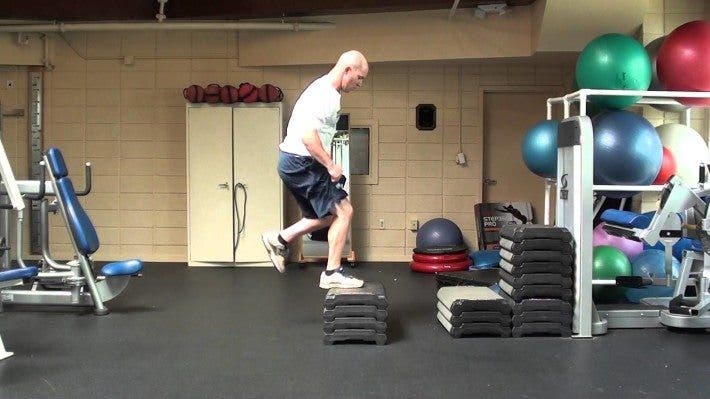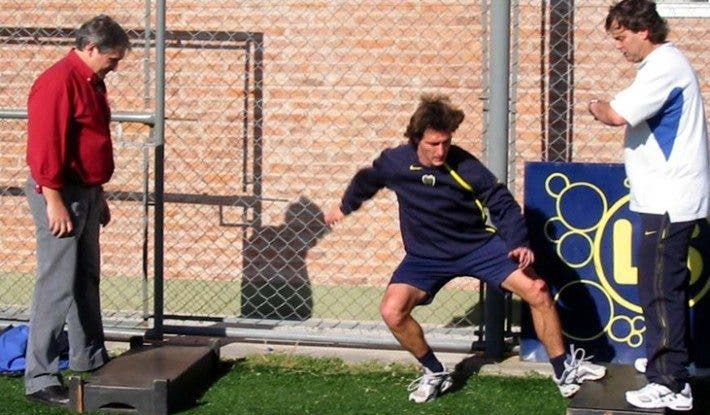In this second part of the article, we will enter fully into the distribution of the training method for each level, breaking down each day of it into its corresponding jumps. In general (except for advanced levels), they consist of 3 training days , 48 hours apart (Monday, Wednesday and Friday for example), in sessions that last about 20-25 minutes . The program should be accompanied by strength training to be performed in different sessions preferably, and if this is not possible, plyometric training precedes weight training.

Level 0
It is an adaptation phase, and is used basically with athletes aged 12-13 years in the pre-pubertal stage. Multiple jumps are made at 1 foot (hops on the limp), varying directions, ending the series with the fatigue of the twin , at which point he turns with the other leg. About 10 different exercises. Because rest time is minimized, the session at this level 0 lasts about 10 minutes. These exercises cause a strengthening of the joints and muscles of the plantar arch of the foot in adolescents. The duration of this level is 4 to 6 months . It is important to perform the exercises barefoot, and on hard surfaces. An example of a session of this level is the one in this video (you can also see jumps with 2 feet, which work as a warm-up to the 1-legged series). The ideal would be to do it every day . This phase will cause widening in the ankles and knees, and hypertrophy in the calves.
Level 1
This level is where most athletes start. Almost everyone has low levels of reactive strength before training. We can verify this when the difference between the CMJ and the SJ is less than 10% (check the 1st part of the article, where the different types of jump tests that are carried out in this method are explained). In addition to training reactive strength, this level incorporates coordination , something very important for any athlete, and often undervalued in the physical preparation of any sport.
Level 1 distribution
It consists of 3 days of work , for 4 weeks , in which the volume of work increases from one week to the next. On the 1st day of week 1, 300 jumps will be performed (10 exercises, 3 sets of 10 repetitions), on 2 250 (8 exercises), on 3 300. ( * note : There is some slight variation with the total weekly volume of jumps that it can be seen in some of the videos, such as the one that will be cited below. Here we have followed the distribution that comes in one of his books, “Updates on power training”).
| Week / day | Day 1 | Day 2 | Day 3 |
|---|---|---|---|
| Week 1 | 300 | 250 | 300 |
| Week 2 | 300 | 300 | 300 |
| Week 3 | 350 | 300 | 300 |
| Week 4 | 350 | 350 | 300 |
As you can see, the volume of weekly jumps is increasing every week. 850 jumps on week 1, 900 on week 2, 950 on 3, and 1000 on 4. To avoid doing this count, it will be easier to control the number of exercises , assuming that 3 sets of each will be performed, of 10 repetitions each . On the days of 250 jumps, 8 exercises will be performed, on the days of 300 10 exercises, and on the days of 350, 12 exercises. It must be clear that they are multi-jumps, that is why the volumes of jumps are so high.
Each training day of the week is characterized by jumps of a different type.
Day 1
On day 1, the agility ladder, the jump rope, and the quadrilateral, or a hexagon, are used with markings on the ground. They are proposed tools to carry out training in a more fun way. 80% of the exercises are performed with the ladder, and the other 20% between rope and quadrilateral. This is a random distribution, but logical, since the ladder allows greater variability in the exercises, which interests us so as not to generate overload patterns (Paul Chek, an expert kinesiologist, defines these overload patterns as soft tissue injuries such as result of repeated movements in a movement pattern). The multi-jumps of this first day are mostly with the 2 feet together, falling on the balls of the feet , without supporting the entire sole of the foot at any time, and as always, the contact time with the ground is minimal, and looking for the maximum height in each jump.
The time between exercises is minimal. If it is done in team sports, the ideal is to distribute the workstations in groups of 3-4 players . While 1 is active, the others rest.
8 – 12 exercises , depending on the total volume that we touch for each session, performed in 3 series of 10 jumps .
Why 10 jumps?
Because it is proven (with the multi-jump evaluation that measures the evolution of the contact time with the number of jumps, seen in the first part of the previous article) that from that amount approximately, the quality of the jump begins to decline. It could be fine-tuned in a team sport, evaluating each player to find out what their optimal number of multi-jumps is.
Multi-jump with rope
Normal 2-foot jumps, 1-leg jumps, 1-leg forward jumps are some examples. At minute 24:50 of the following video they appear.
Agility ladder
This utensil allows infinite exercises. From minute 27 several cases appear.
Square or hexagon
With 1-2 exercises with this device, we would finish this 1 day.
Day 2
For the 2nd day, we will need to have a few steps, or something similar to perform the “prisoner” exercise and its variants (When I do this day I use a ladder rung, and a cut pallet). With the incorporation of this exercise, different angles of jumping are sought. To perform the “prisoner” position, the front foot slightly bent towards the middle so that the knee is locked, and the rear foot with the heel pointing back and the knees bent. It is a position similar to that of fencers. From there, jump around with various variables. This prisoner work by itself only increases the squat jump , and therefore the strength in the legs.
In the following video we have an example with several exercises for this day 2.
Day 3
For day 3, plastic fences with adjustable heights are used, and where their height will be limited by the “optimal fall height” calculated above. Ideally, most of these fences have lower heights, and only some have that height. All kinds of multi-jumps are made, with twists, backwards, sides, the combinations are endless.
Again we turn to the 2nd video added above, where several examples appear at minute 52.
In these exercises we can already increase the pause between passes and between series a little more, depending on the level of the athlete. 30 ″ between passes, and 2-3 minutes between different exercises , so that the legs recover between exercises. In elite athletes, it is possible to work with a 5 ”-8”: 15 ”format (5” -8 ”for exercise, 15” for rest).
Level 2
To access this level, you must complete level 1, or you should have an optimal fall of 40 cm or more .
At this level they also train for 3 days but the total volume is reduced, because the jumps are more demanding.
| Week / day | Day 1 | Day 2 | Day 3 |
|---|---|---|---|
| Week 1 | 250 | 250 | 200 |
| Week 2 | 300 | 250 | 250 |
| Week 3 | 300 | 300 | 250 |
| Week 4 | 300 | 300 | 300 |
Day 1
The same tools of level 1 are used (camber, ladder and quadrilateral or hexagon), but we use jumps with 3 different angles of the knee joint :
- Legs almost extended (normal multi-jump)
- Squats (90º)
- Full squats (40º)
That is to say, the jumps on the coordination ladder, to the rope, or on the hexagon, must be of the 3 types. I notice that squatting leaves your quadriceps fried, and with significant stiffness in the next 24-48 hours. In minute 60 of the previous video several examples appear.
Day 2
This day the lateral movement with jump is worked , both with steps, as lateral jumps in hurdles, as lateral jumps in stairs. The falls and take-offs will be varied, being able to incorporate turns, or vary the height of the steps on one side if, and not on the other, etc. For the very good, you can also work with a harness tied to the waist, and elastic bands tied to it on one side, and to a fixed point on the other, or controlled by 2 colleagues who, located one on each side of the other, give jerks, to cause extra inertia, over accelerating the athlete. At the speeds generated by the jerks of the partner while the athlete moves laterally, he must be able to brake, and change direction.

Day 3
Here the fences are used again. Not all fences will have the optimal drop height (half can be placed, for example). The jumps to the box or to the bench appear , which must be of the optimal height, and falling on it with the legs almost extended.
Level 3
At the end of level 2, the athlete is reevaluated, and his CMJ must already be 20% higher than his SJ.
Increase the intensity, since all the jumps have the optimal fall height of the deep jump , and therefore the number of sessions per week is reduced to 2.
It is a maintenance phase, since it is difficult to continue increasing the reactive strength of the athlete.
| Week / day | Day 1 | Day 2 | Day 3 |
|---|---|---|---|
| Week 1 | 250 | 300 | 200 |
| Week 2 | 300 | 300 | 250 |
| Week 3 | 350 | 300 | 250 |
| Week 4 | 350 | 350 | 300 |
Ladders and bases with fences are also used (the same exercises in level 1 and 2). You work a lot on 1 leg, so as not to perform multi- jumps at very high heights, since we insist, all jumps at this level are with the height of the fence that has come out of the optimal fall height in the reassessment at the end of the level 2, and that it can be 70-80 cm or more in athletes with a very high reactive force, which would mean that the spine would have to withstand high impact forces with each multi-jump. In single-leg jumps, the optimal landing height for 1 leg should be used. Weighted vests can also be used to avoid having to jump from very high heights.
* Note: In the consulted bibliography a level 4 appears, but according to other videos and conferences of the author that I have, it seems that it is regrouped in level 3.
Sources:
- Updates on Power Training , Horacio Anselmi